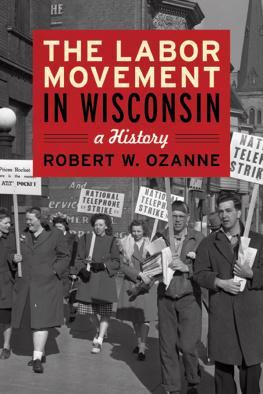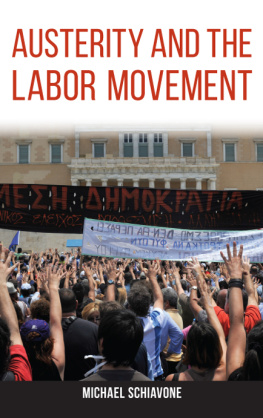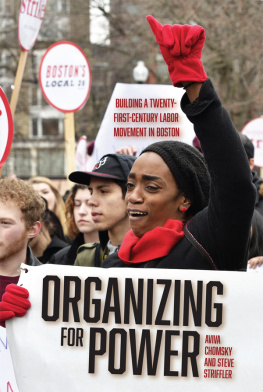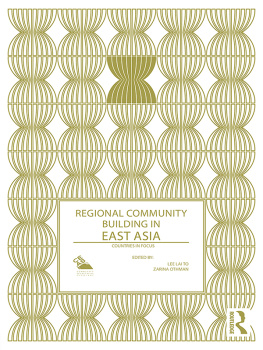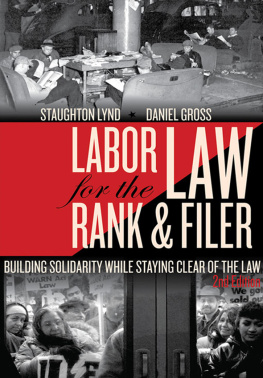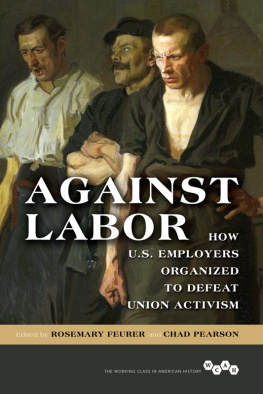A New New Deal
How Regional Activism Will Reshape the American Labor Movement
Amy B. Dean and David B. Reynolds
Foreword by Harold Meyerson
A Century Foundation Book
ILR Press
an imprint of
Cornell University Press
Ithaca and London
For my mother,
Theodora Teddie Radove Dean
(19391997)
and for
Loyd Williams, Business Manager from 19932004, Plumbers, Steamfitters and Refrigeration Workers Local 393
Teddie treated everyone with dignity and respect. In her worldwhich can one day be our worldpeople were valued for who they are and what they contribute. My lifes work in the American labor movement is a tribute to her enduring influence.
Loyd was a modern-day Walter Reuther, Sidney Hillman, and A. Phillip Randolph. His heart was big enough to support a whole community.
We hear it beating still.
Amy Dean
For my mother, Mary Reynolds (19232006), whose strong will, questioning mind, and passionate commitment to social justice continues to animate my life and work.
David Reynolds
Contents
Foreword
One of the happiest accidents of my life was to be in the right place at the right time to see a labor movement turn a city around. The place was Los Angeleshistorically a bastion of antiunion sentiment. The time was the 1990s, when I was the political editor of the L.A. Weekly and when a young labor leader, Miguel Contreras, aligned the citys reawakening union movement with the burgeoning Latino immigrant community to create a progressive force that transformed L.A. into a solidly liberal city, and one that implemented policies to lessen the yawning gap between rich and poor.
Miguel was one of two California labor leaders who lit out during the 90s for this uncharted territorybuilding a dynamic local labor movement that tackled the growing inequality that increasingly defined Americas cities. The other was Amy Dean, who headed the AFL-CIO in the community that came to symbolize American innovation and prosperity: Silicon Valley. Like their counterparts in Los Angeles, however, the workers for whom Amy spoke shared none of the storybook prosperity of the high-tech boom. The men and women who cleaned their cities office buildings and made them glisten in the California sun worked long hours for low pay.
What Amy and Miguel confronted were the hard realities of postNew Deal Americaa place where manufacturing and unions were in decline, where retail and service-sector jobs that paid little and offered no benefits were on the rise, where economic security was vanishing, and where the federal government, in the sway of Reagan-age ideologies, had no inclination to restore it. Nationally, the union movement, while struggling to grow again, remained weak and largely unable to arrest Americas galloping inequality. The very idea that local collections of unions could prod their local governments to enact the kind of egalitarian policies that the federal government had once enactedpolicies to raise the wages and provide benefits to workersseemed fanciful, if not absurd.
And yet, thats what happened in Los Angeles and in San Jose and in cities up and down California and then across America. Amy and Miguel, in concert with other visionary labor leaders in their cities and in others, set up organizations that provided authoritative research on how the other half lived within their cities. They set up community alliances that pushed local governments to enact living-wage ordinances for employees of companies with municipal contracts and implemented community benefit agreements that created jobs for the residents of downtown areas where glass and steel towers rose to the sky. They established political operations that turned out the volunteers who elected politicians committed to policies of broadly shared prosperity and environmental justice.
They encountered setbacks along the way, of course. In some cities, unions proved resistant to the kind of labor-community alliance it takes to build power; in other cities, the funding base for these kinds of activities proved too narrow; and in still other cities, movements to ensure that prosperity would be broadly shared failed in the absence of sufficient prosperity to go around. But in many cities, these labor-based movements for economic justice have bettered the lot of tens of thousands of workers and their families, and mobilized whole new constituencies of progressive voters in the process.
This is the story that Amy Dean and David Reynolds of Wayne State University tell in this important book. Coming at a moment when a new president is determined to use the power of government to rebuild a middle class, when activists are looking to new forms of organizing and politics to build a better nation, when the labor movement is casting about for new ways to help working people win more secure lives, A New New Deal couldnt be more timely.
Even in this era of virtual reality, political movements come from places. Franklin Roosevelts New Deal came off the sidewalks of Fiorello La Guardias and Sidney Hillmans and FDRs own New York. Barack Obamas new new deal, if it succeeds, will be able to claim its own rootsSaul Alinskys Chicago, of course, but also Miguel Contrerass Los Angeles and Amy Deans San Jose.
Get a jump on the historians. Read about them here.
Harold Meyerson
Harold Meyerson is Editor at Large of the American Prospect and an op-ed columnist for the Washington Post . From 1989 through 2001, he was executive editor of the L.A. Weekly .
A Note from The Century Foundation
At the time of this writing, a vivid (and painful) new chapter in American and global economic history is being written. Given the scale and consequences of the present sharp financial decline, we also can be certain that it will be analyzed and reanalyzed extensively as future scholars pore over the evidence about what precipitated the collapse and what was done to halt and reverse the decline. Economics doctoral candidates yet unborn will slice and dice this history while filling bookshelves with richly detailed meta-analyses of this recession.
It is clearly hazardous, then, to venture any predictions of where the consensus about causes will wind up. Nonetheless, I will take a guess that no serious person will find that the cause was the overweening strength of labor unions in the United States. The woeful tale of union decline has been told many times. And, strikingly, even in the current crisis, the bulk of attention that unions are receiving in the press involves internecine battles, almost incomprehensible to outsiders. At the same time, it is hard to believe that the labor movements future will not be profoundly affected by the many impacts of the recession of 2008 and beyond.
There is ample reason to believe that our economic architecture will change dramatically in the years to come. As we achieve a new normal, we may find regulatory and tax structures altered, and compensation and accounting practices changed. Therefore, it is reasonable to ask how the relationship of workers to their employers and to one another may change. If there is constructive development as a result of the current turmoil, it seems likely that one blueprint for a revived unionism will be that described and proposed in the pages that follow. It is a model that is simply too good to ignore.
Today, labor unions often seem too small to matter, with their greatest membership being in the special case of public employees. Elsewhere, they have been ineffective in reversing the trends toward greater inequality and wage stagnation. They have lost the battle to retain defined benefit retirement plans, as defined contribution plans (where the risk is greater for workers) have become the normthat is, for those with any retirement plan at all.


